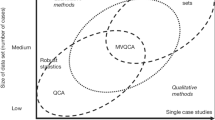Abstract
Contextual analyses are essential in comparative research, as they investigate the importance of contextual conditions for causal relationships. During the last decades, an increasing number of comparative studies have also focused on how contextual conditions affect causal relationships. At the same time, new comparative methods have been developed based on set-theoretical logics. Two of the most prominent methods are csQCA and fsQCA, which are used in comparative studies with increasing frequency. However, the conventional design for contextual analysis is still based on quantitative methods and the use of interaction-factors. This article discusses why the use of interaction-factors is not suitable together with QCA-methods. Instead of the conventional design, the article presents an alternative design for contextual analyses with QCA-methods grounded on subgroup-design. Based on one recently-developed methodology comparative multilevel analysis (CMA), some guidelines for performing contextual analyses with two set-theoretical methods (csQCA and fsQCA) are presented. As illustrated with examples, the combination of CMA and QCA provides opportunities to use QCA for contextual analysis.

Similar content being viewed by others
Notes
Positive conditionally means that the presence of contextual condition is necessary for the existence of causal relationship, while negative conditionally refers to when the presence of contextual condition dissolves the causal relationship.
In the following examples (Tables 3, 4), coefficients for consistency and coverage are used. However, fsQCA offers additional coefficients that indicate theoretical set-relationships and can be used in contextual analyses with CMA. For example, when combinations of conditions are analyzed, different aspects of theoretical set-relationships are indicated by solution consistency, solution coverage, raw coverage, and unique coverage (Ragin 2008; Schneider and Wagemann 2012). These coefficients, in combination with CMA, provide opportunities to analyze how context affects different aspects of causal relationships.
References
Aneshensel, C.S.: Theory-Based Data Analysis for the Social Sciences. Pine Forge, Thousand Oaks (2013)
Boix, C.: Democracy, development, and the international system. Am. Political Sci. Rev. 105, 809–828 (2011)
Brambor, T., Clark, W., Golder, M.: Understanding interaction models: improving empirical analyses. Political Anal. 14, 63–82 (2006)
Bunge, M.: Finding Philosophy in Social Science. Yale University Press, New Haven (1996)
Coleman, J.S.: Foundations of Social Theory. Belknap Press, Cambridge (1990)
Denk, T.: Comparative multilevel analysis: proposal for methodology. Int. J. Soc. Res. Methodol. 13, 29–39 (2010)
Falleti, T.G., Lynch, J.F.: Context and causal mechanisms in political analysis. Comp. Political Stud. 42, 1143–1166 (2009)
Franzese, R.J.: Multicausality, context-conditionality, and endogeneity. In: Boix, C., Stokes, S.C. (eds.) The Oxford Handbook of Comparative Politics, pp. 27–72. Oxford University Press, Oxford (2007)
Franzese, R.J., Hays, J.C.: Interdependence in comparative politics: substance, theory, empirics, substance. Comp. Political Stud. 4(5), 742–780 (2008)
Galton, F.: On a method of investigating the development if institutions applied to the laws of marriage and decent. J. Roy. Anthropol. Inst. 18, 272 (1889)
Goertz, G.: Contexts in International Politics. Cambridge University Press, Cambridge (1994)
Goertz, G., Mahoney, J.: A Table of Two Cultures: Qualitative and Quantitative Research in the Social Science. Princeton University Press, Princeton (2012)
Goldstein, H.: Multilevel Statistical Models. Arnold, London (2003)
Grofman, B., Schneider, C.Q.: An introduction to crip-set QCA with a comparison to binary logistic regression. Political Res. Q. 62, 662–672 (2009)
Iversen, G.R.: Contextual Analysis. Sage, Thousand Oaks (1991)
Jahn, D.: Globalization as ‘Galton’s problem’: the missing link in the analysis of diffusion patterns in welfare state development. Int. Organ. 60, 401–431 (2006)
Kam, C.D., Franzese, R.J.: Modeling and Interpreting Interactive Hypotheses in Regression Analysis. The University of Michigan Press, Ann Arbor (2007)
Mackie, J.: Causes and conditions. Am. Philos. Q. 2, 254–264 (1965)
Naroll, R.: Two solutions to Galton’s problem. Philos. Sci. 28, 15–39 (1961)
Naroll, R.: Galton’s problem: the logic of cross-cultural analysis. Soc. Res. 32, 428–451 (1965)
Przeworski, A., Teune, H.: The Logic of Comparative Social Inquiry. Wiley, New York (1970)
Ragin, C.C.: The Comparative Method: Moving Beyond Qualitative and Quantitative Strategies. University of California Press, Berkeley (1987)
Ragin, C.C.: Fuzzy-Set Social Science. The University of Chicago Press, Chicago (2000)
Ragin, C.C.: Set relations in social research: evaluating their consistency and coverage. Political Anal. 14, 291–310 (2006)
Ragin, C.C.: Redesigning Social Inquiry: Fuzzy Sets and Beyond. The University of Chicago Press, Chicago (2008)
Ragin, C.C.: Qualitative comparative analysis using fuzzy sets (fsQCA). In: Rihoux, B., Ragin, C.C. (eds.) Configurative Comparative Methods: Qualitative Comparative Analysis (QCA) and Related Techniques, pp. 87–121. Sage Publications, London (2009)
Rihoux, B., Ragin, C.C. (eds.): Configurative Comparative Methods: Qualitative Comparative Analysis (QCA) and Related Techniques. Sage, London (2008)
Rohlfing, I.: Analyzing multilevel data with QCA: a straightforward procedure. Int. J. Soc. Res. Methodol. 15, 497–506 (2012)
Schneider, C.Q., Wagemann, C.: Set-Theoretic Methods for the Social Science: A Gudie to Qualitative Comparative Analysis. Cambridge University Press, Cambridge (2012)
Snijers, T., Bosker, R.: Multilevel Analysis: An Introduction to basic and advanced multilevel modeling. Sage, London (1999)
Tilly, C., Goodin, R.E.: It depends. In: Goodin, R.E., Tilly, C. (eds.) The Oxford Handbook of Contextual Political Analysis, pp. 3–32. Oxford University Press, Oxford (2006)
Wellhofer, S.E.: The comparative method and the study of development, diffusion and social change. Comp. Political Stud. 22, 315–342 (1989)
Author information
Authors and Affiliations
Corresponding author
Rights and permissions
About this article
Cite this article
Denk, T., Lehtinen, S. Contextual analyses with QCA-methods. Qual Quant 48, 3475–3487 (2014). https://doi.org/10.1007/s11135-013-9968-4
Published:
Issue Date:
DOI: https://doi.org/10.1007/s11135-013-9968-4



